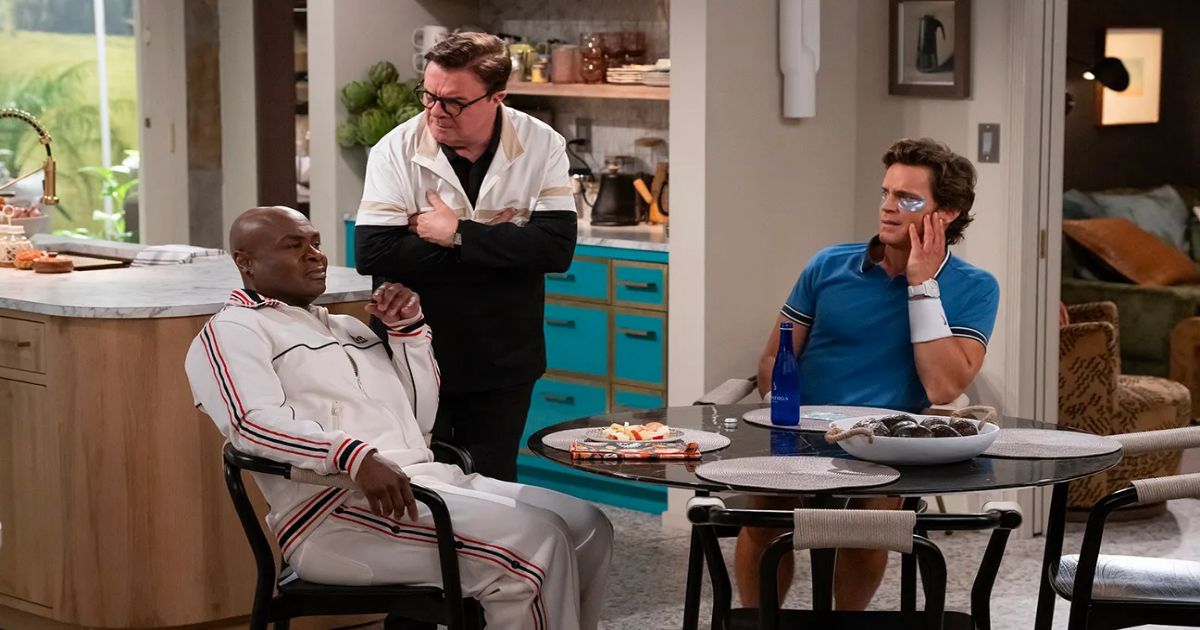The architecturally inspired title of Hulu‘s Mid-Century Modern, a sitcom that has basically nothing to do with architecture, evokes something old yet current, rooted in nostalgia yet generally of-the-moment, behind a cultural curve yet never fully out of style.
Despite the fact that the title has little connection to the content of the series, it’s easy to see why it appealed to creators Max Mutchnick and David Kohan. Mid-Century Modern is an aesthetic throwback to the broadest of broad multi-cams in the ’80s-and-’90s mode pioneered by the legendary James Burrows and directed here by none other than James Burrows, only topically retrofitted for the more progressive and relaxed streaming era.
Mutchnick, Kohan and Burrows broke new ground with Will & Grace, but like the Soap team in the ’80s, they faced many more barriers from the broadcast television landscape. No matter how old-fashioned Mid-Century Modern is, it’s easy to appreciate the liberation its creators feel in having what appears to be no barriers at all, in ditching the double entendres and puns and just kicking things off with the punchline, “You don’t look sad. You just look like a reluctant bottom.”
Will Truman would NEVER. I mean, Jack probably would.
It happens that what Mid-Century Modern lacks is, well, grace. Not the straight woman played by Debra Messing, but the sense of borderline elegance that accompanied the farce on Will & Grace at its peak. With no barriers or restrictions around which to artistically pirouette, Mid-Century Modern ends up being both blunt and bland, occasionally pushing the envelope in creative ways, but more often forcing its exceptional core cast to compensate for stale, predictable punchlines with boundless professionalism and ample energy.
The reluctant bottom in question is Nathan Lane‘s Bunny Schneiderman, struggling to externalize his grief at the funeral of longtime chum George. Bunny, George, former Vogue fashion columnist Arthur (Nathan Lee Graham) and flight attendant and lapsed Mormon Jerry (Matt Bomer) used to be an inseparable quartet, but time, distance and now George’s death have pulled them apart.
Lonely and worried about not having anybody to delete his online search history after his death, Bunny invites Jerry and Arthur to come live with him at his home in Palm Springs. They’ll form a family and support system all under the watch of Bunny’s mother, Sybil (Linda Lavin), a filter-free matriarch prone to quippy insults and hiding her son’s beloved Fig Newtons. For personal reasons and reasons of narrative convenience, they agree.
Lavin died in December, having completed three-quarters of the season, leaving it for Mutchnick and Kohan to honor the stage and screen legend, which happens in the suitably somber and emotional “Here’s to You, Mrs. Schneiderman.”
The series was already, to that point, a lovingly rendered tribute to the brassy Alice star, whose every expertly delivered put-down and tart compliment earns a roar from the appreciative audience. If the series is designed to stir up the affection built up for vintage sitcoms, Lavin is giving the kind of performance that would have earned her multiple supporting actress Emmy wins back in the ’80s, when her competition would have included the women of The Golden Girls, a show Mid-Century Modern is aggressively attempting to emulate. Whether sentiment carries her to one last nomination here is unclear, but there’s an equal measure of mirth and melancholy to seeing Lavin go out in such fine form.
On the Golden Girls front, Bomer’s Jerry is very obviously patterned after Betty White’s Rose, substituting LDS memories for stories about St. Olaf. It’s a reminder of how difficult it is to write a character as naive-yet-wise as Rose Nylund was, because Jerry comes across as a collection of dim-bulb eccentricities instead of a person. The odd thing is that although Bomer isn’t a natural sitcom actor, when he’s freed from the flaccid “good-natured dumb himbo” punchlines that don’t even seem to be amusing the audience, he’s actually excellent. Before Lavin’s death shrouds the season’s homestretch in grief, the best dramatic beats come from Bomer, whose character gets some sweet scenes with a closeted young Mormon and one solid episode featuring Billie Lourd as Jerry’s long-estranged daughter.
Graham and Lane are more instantly comfortable with the format, hitting each punchline hard, like it’s a source of pride to be able to introduce the audience to jokes about pillow queens, starfishing and a bar named Fisty’s. They’re funny in similar ways, one with an excess of confidence covering for his inner insecurities and one with an additional level of Jewish stereotyping embellishing his outer insecurities. The warmth between the three leads is believable and although the tendency to have Lane, Bomer and Graham break into choreographed song and dance routines for episodic climaxes quickly feels lazy, a cold open homage to Chicago produced my biggest laugh of the 10-episode season.
The four leads, plus the creative talent behind the camera — additional producers include Ryan Murphy, Don Roos and Suzanne Martin — are a big enough draw for an impressive guest cast as well. Pamela Adlon is a standout as Bunny’s sister (a character I’m sure the producers would love to use as a Lavin replacement in a second season), with Richard Kind, Judd Hirsch and Rhea Perlman among other welcome favorites. Stephanie Koenig from English Teacher makes a less successful guest appearance as a pastiche of a Republican congresswoman whose lone episode proves conclusively that issue-oriented humor is not what this show does well.
Instead, Mid-Century Modern is more at ease with simple, situation-driven plots. There’s an episode set largely in a bar (or “generic bar set”) in Fire Island, another on a cross-country flight (or “generic airplane set”) and various other installments lounging around Bunny’s Palm Springs house, which seems to be a magnet for young hunks whom the gang pursue in ways that are meant to be charmingly predatory. I made more frequent note of funny things the stars were doing than funny things the show achieved, as more than a few episodes flounder in callbacks and repetition, without building the humor to a graceful crescendo.
The show is determined to have heart, and pauses the laughs at multiple points for sincere beats that can be summarized simply as: “It was a long journey that brought us to this place where we can laugh about some of this stuff without subterfuge.” And it isn’t wrong! Mid-Century Modern may be the best show of 1987 that couldn’t have possibly been made in 1987. It back-fills a cultural void in a way that represents moving forward and backward at once, albeit probably more the latter.



